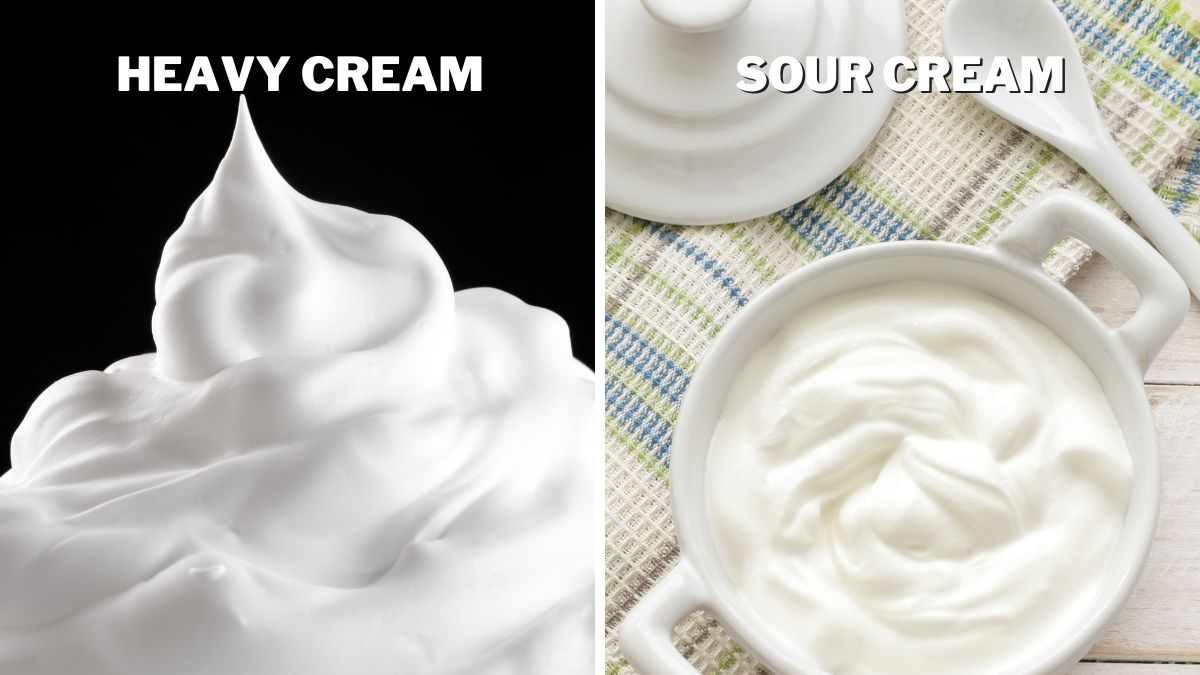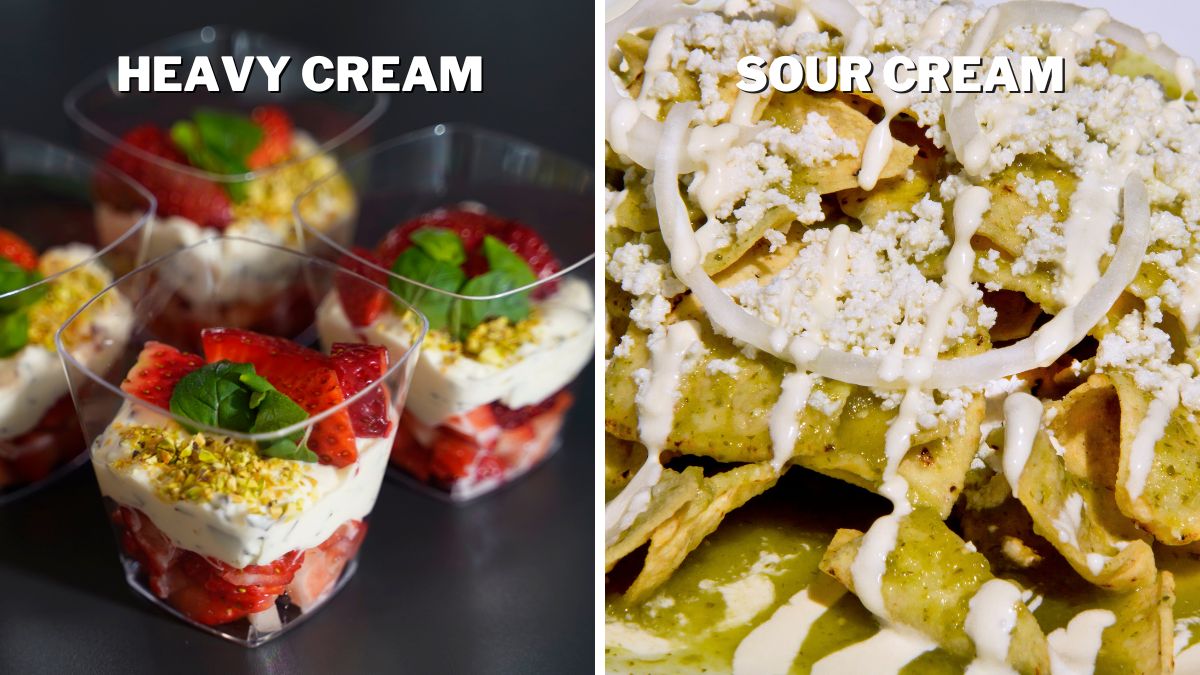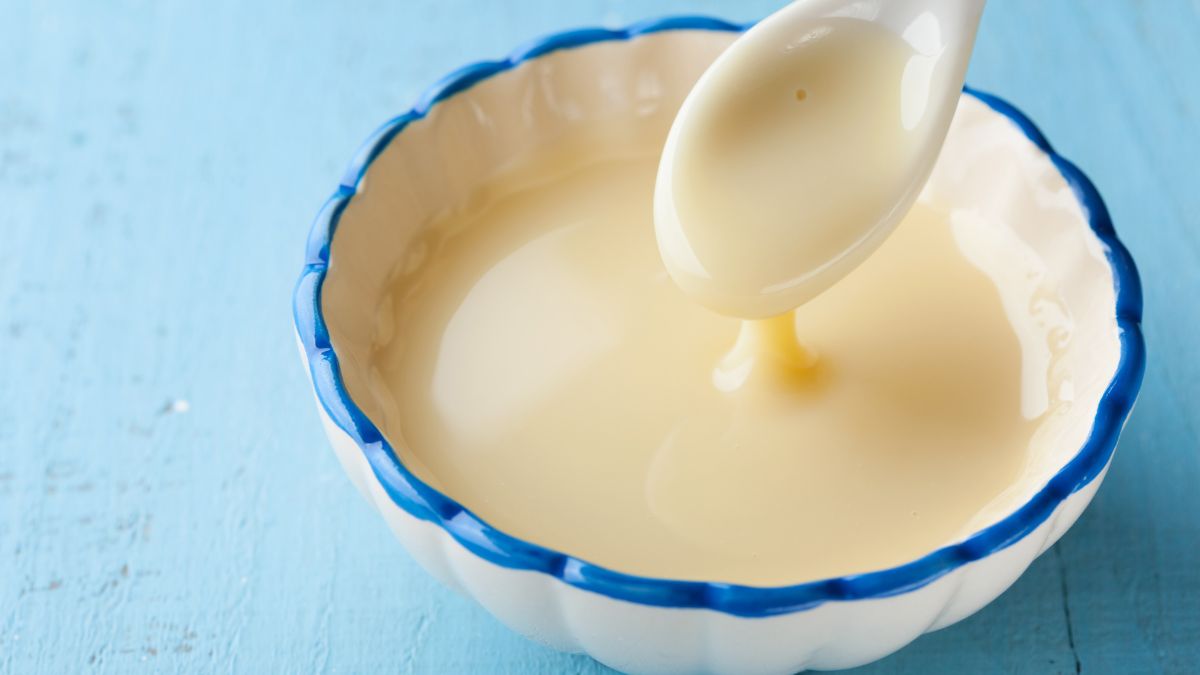Heavy Cream vs. Sour Cream: Differences & Uses

There’s no dish that heavy cream or sour cream cannot improve, but you have to know where to add each so they can do their job properly. Since I use them daily, they are very important in my kitchen. Knowing the difference between heavy cream and sour cream may not be discovering the secret of the universe, but it is pretty important if you want your dish to taste good. So, what are the differences between heavy cream and sour cream?
Heavy and sour cream differ in fat content, taste, and usage. Heavy cream has around 36-40% fat, and it is the fatty part of milk that separates when heated. Sour cream is made by fermenting regular cream with specific bacteria. It has about 18-20% fat and can be used fresh and uncooked as well as in cooking.
In this article, I will tell you all about the differences between heavy and sour cream and their uses. While both can do an excellent job, the two are not as interchangeable as you may think. I know the importance of knowing how and where to use them, but I think that you should, too. So, let’s dive in!
Appearance and Consistency

As someone who spends a fair amount of time in the kitchen, I’ve had my fair share of experiences with both. Though they might seem similar at first glance, they actually have quite distinct differences in appearance and consistency. Don’t let the appearance fool you, as they are more different than similar.
Heavy cream has a smooth and pourable consistency, much like whole milk, but thicker and richer. Its color is pale, something like eggshell, it’s creamy, and you will have no trouble pouring it. It doesn’t drip or slide but flows as a thick liquid.
Such consistency makes it perfect for sauces like alfredo or béchamel, making the dishes richer and more elegant. Heavy cream does great when whipped, too. It transforms into an airy, cloud-like, and fluffy topping which is why it is often used to decorate desserts.
Sour cream, on the other hand, has a significantly thicker consistency that easily holds its shape. It is brighter colored than heavy cream, with a fresh white color, which is most noticeable when you use a scoop of sour cream as a vegetable or pizza topping.
While heavy cream blends with the food, making it creamier, sour cream stands out, and you can easily spot it. As a topping, sour cream stands stable on the surface while curdling when cooked. Therefore, I give it some serious elbow action when I cook with it in order to homogenize it with the rest of the ingredients.
This is because the fermentation process that creates sour cream results in a thicker, more stable texture.
The differences between the two become most apparent in the kitchen, and you can’t use them the same way. You can whip heavy cream or mix it into sauces, dips, or other types of food.
Due to its lower fat content and higher acidity, sour cream does not whip and tends to curdle when you cook it. Still, while you must process heavy cream in some way, whether through whipping or cooking, you can use sour cream as it is.
In a nutshell, even though they are dairy products, their appearance and consistency are very different. Heavy cream is smooth, pourable, and pale, and sour cream is thicker, bright white, and stable.
Taste
The taste is probably where the differences between sour cream and heavy cream are most noticeable and important to know. Since both are staples in my kitchen, for me, it is essential to know the taste of each so that I know how to use them.
Sour cream and heavy cream are both used to add creaminess to food. Still, sometimes creaminess means nothing if it isn’t accompanied by deliciousness.
As the name itself reveals, heavy cream is just that, a cream that is heavy. It is rich, thick, and luxurious, and it is indeed heavy if you go too far. Heavy cream has a velvety, smooth, and mildly sweet taste, making it perfect for situations when you want to add some luxury and substance to your dish.
I love it in pasta sauces and dips, as well as whipped on top of cakes and pies. Still, a word to the wise, be careful with heavy cream because it can easily turn against you.
Sour cream is tangy and slightly acidic; it is creamy but thinner than heavy cream because of the lesser fat amount. Since heavy cream is pourable and sour cream isn’t, you would think that sour cream is the thicker one, but it is the other way around.
They both have unique flavors that make them suitable for different uses. As a passionate cook, these ingredients are among the main ones in my kitchen arsenal because I do need them both as they don’t substitute for one another frequently.
The next time you’re in the mood to experiment, decide which flavors you’d like to achieve, which will help you go for the right enhancement, whether that is sour cream or heavy cream.
Uses

Since they are so different in flavor, it comes as a logical conclusion that they differ in their uses too. When I’m in the mood for something more complex, with a touch of velvet and elegance, I go for heavy cream, while sour cream is there when I want a quick and tasty refreshing bite. I love having them both at my disposal, and both can do wonders when used correctly.
Heavy cream is excellent when you want to make something creamy and sinfully rich. It is perfect for adding smoothness to soups, sauces, and especially pasta dishes. Heavy cream thickens and develops a rich, creamy texture that can enhance any dish when simmered.
However, its application is tied to cooking, as there aren’t many situations where you can use it as it is. An exception would be whipping it, but even then, it isn’t unchanged but mechanically processed. Adding it to tea or coffee is pretty much where you can use heavy cream uncooked.
On the other hand, you can use sour cream right from the packaging. Just scoop it and put it wherever you want, which is why it is such a famous topping. Unlike heavy cream, sour cream doesn’t mandate cooking and works excellently fresh. You can use it to thicken soups, add it to vegetable and fruit salads, top pizza with it, smear it on your breakfast toast, or season it as a refreshing dipping sauce.
As I mentioned earlier, when sour cream curdles while cooking, you need to mix it well to homogenize it with the rest of the ingredients. It thickens the dish, but it doesn’t give it the heavy creaminess cream provides.
In essence, heavy cream is better to cook with, and sour cream is better to have fresh. Still, if that’s your preference, go ahead and add a scoop to whatever you are making; it will be tasty anyway.
Nutrition
The different preparation processes cause sour cream and heavy cream to differ in terms of nutrition as well. I use sour cream more frequently as it is the healthier option, but don’t be afraid to treat yourself to the luxury of heavy cream from time to time.
Since heavy cream is the fatty part of the milk that separates when heated, it naturally has more fat than sour cream, i.e., almost double the amount in sour cream. So, if you are looking for a fattier dish, heavy cream is your solution. Sour cream is made through fermentation using lacto bacteria, so it isn’t as fatty and is good for digestion and gut health. [1]
Both contain protein, with heavy cream being marginally protein-richer. Sour cream is a better source of calcium than heavy cream, while heavy cream contains a considerable amount of vitamin A.
They both contain vitamin D and are low in carbs. Heavy cream also has health benefits due to its rich nutritional value, but it has also been linked to the risk of obesity and other weight-related problems. [2]
As a general rule, I tend to use heavy cream less often than sour cream, but I don’t want to overdo it, either. I would say that in moderation, they can be a part of a healthy diet.
Production
The making process is where it all boils down to. Both heavy cream and sour cream use the same raw material, i.e., milk, but because they have been produced differently, they result in such significant differences.
Heavy cream is produced by skimming the rich, fatty layer off the top of whole milk when it’s fresh. This layer contains a high-fat content, usually around 36% or more, which is what gives heavy cream its thick and velvety texture.
The making process is very simple, actually, and you can easily make it at home. Heat the milk until the top fatty layer separates. Skim the butterfat, and there you have it.
Store-bought heavy creams have additives and stabilizers, but the principle is the same.
Sour cream calls for a more complex making process. It is made by fermenting regular cream with lacto bacteria, converting the lactose in the cream into lactic acid. This process makes sour cream taste tangy and thickens its consistency.
Substitutes
The thing I love most about sour cream and heavy cream is that I can easily substitute for them if I don’t have them. Heavy cream is very similar to evaporated milk, but if you don’t have it, regular milk can also do the trick if you need it for cooking.

A mixture of butter and milk also does a great job, as well as cream cheese, coconut cream, milk and cornstarch, cottage cheese and milk, or tofu and soy milk.
You can substitute sour cream with Greek yogurt, crème fraiche, Kefir, cottage cheese, mayo (which substitutes more for creaminess and not for the flavor), as well as low-fat cream cheese.
Choose the substitute depending on what you make, as none of them substitutes all aspects of sour cream or heavy cream.
Storing and Shelf Life
Both heavy cream and sour cream are perishable products, so don’t play fast and loose with the expiration date or ignore any signs of spoilage. You can use them roughly for the same amount of time which is about two weeks after opening and a month if you store them unopened.
Regardless of whether they are open or unopen, you need to keep them in the fridge at all times and never at room temperature for over half an hour. Don’t freeze either, as they don’t do well when defrosted.
Are Heavy Cream and Sour Cream Interchangeable?

Heavy cream and sour cream are interchangeable in some situations, but not always. For example, you can use heavy cream for desserts, but you can’t use sour cream for the same purpose. You can use sour cream fresh as a topping, while heavy cream doesn’t do well in these cases.
Still, in between, there is a grey zone where you can substitute one for the other, but the resulting flavor will be different. You can use both for soups, but the heavy cream soup will be richer and creamier than the one with sour cream.
Pasta does well with both, but sour cream pasta isn’t as creamy and has a slightly tangy taste. Both do well in sauces, but again, the flavors are different, i.e., sour cream sauces are slightly tangy and not as thick. Mashed potatoes do well with both, as well as cheesecakes.
